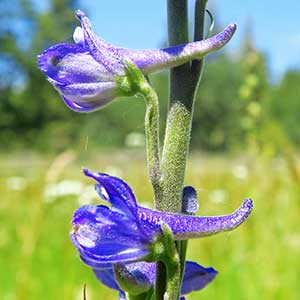Delphinium luteum
Delphinium distichum
golden larkspur, yellow larkspur
Burke's larkspur, meadow larkspur, strict larkspur, two-spike larkspur
20-40(-55) cm;
base often reddish, nearly glabrous.
(25-)30-60(-80) cm;
base sometimes reddish, puberulent.
blade round to pentagonal, 1-5 × 2-10 cm, nearly glabrous; ultimate lobes 3-5, width 8-30 mm (basal), 5-15 mm (cauline).
blade cuneate to semicircular, 1-5 × 1.5-7 cm, puberulent; ultimate lobes 5-19, width 2-8(-15) mm (basal), 0.5-3(-5) mm (cauline);
margins of basal leaf, measured less than 1 cm from blade base, demarcating considerably more than 90° of arc when leaf laid flat;
most cauline leaf blades exceeding internodes.
5-25(-37)-flowered;
pedicel (1-)3-5(-7) cm, puberulent;
bracteoles 6-10(-17) mm from flowers, green, linear-lanceolate, 6-7 mm, nearly glabrous.
8-30(-40)-flowered, usually dense;
pedicel 0.5-1.5 cm, puberulent;
bracteoles 0-3 mm from flowers, green to blue, linear, 4-8 mm, puberulent.
sepals bright yellow, puberulent, appearing waxy, lateral sepals ± forward pointing, (11-)14-16 × (6-)9-13 mm, spur straight, ca. 30° below horizontal, 11-20 mm;
lower petal blades elevated, exposing stamens, 3-4 mm, clefts 0.5-1.5 mm;
hairs sparse or absent, ± evenly distributed if present, white to yellow.
sepals dark blue to bluish purple, puberulent, lateral sepals ± erect, 8-12 × 3.5-5 mm, spurs straight, horizontal or nearly so, 9-15 mm;
lower petal blades ± covering stamens, 4.5-6.5 mm, clefts 2-3 mm;
hairs centered mostly near base of cleft, white.
11-14 mm, 3.5-4.5 times longer than wide, glabrous.
7-13 mm, 3.5-4 times longer than wide, ± puberulent.
unwinged;
seed coat cell surfaces smooth.
seed coat cells with surfaces roughened.
= 16.
Delphinium luteum
Delphinium distichum
Of conservation concern.
Delphinium luteum is presently known from only three populations. It is known to hybridize with D. decorum and with D. nudicaule. Populations of D. hesperium subsp. hesperium also occur at the type locality; D. luteum flowers earlier and hybrids are not known.
Delphinium luteum is not likely to be mistaken for any other species of Delphinium. It has been treated as a variety of D. nudicaule and is closely related to that species. Sepals of the infrequent yellow-flowered phase of D. nudicaule, however, have a much drabber appearance compared with the bright shining yellow of the sepals in D. luteum.
(Discussion copyrighted by Flora of North America; reprinted with permission.)
Delphinium distichum hybridizes with D. multiplex and D. nuttallianum (D. ×diversicolor Rydberg). The name D. burkei has often been misapplied to D. distichum.
(Discussion copyrighted by Flora of North America; reprinted with permission.)
- Local floras:
BC,
OR,
WA
- Local Web sites:
Flora NW,
PNW Herbaria
WildflowerSearch
iNaturalist (observations)
USDA Plants Database
- LBJ Wildflower Center
- SEINet
- Plants of the World Online
- Encyclopedia of Life
- Wikipedia
- Google Image Search


